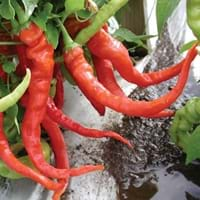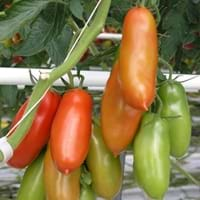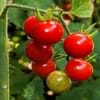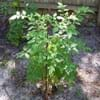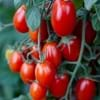Life Span
Annual
Perennial
Origin
Mexico, Central America, South America
Mexico, Central America, South America
Types
Not Available
Round tomatoes, Cluster tomatoes, Heirloom tomatoes, Roma tomatoes
Habitat
Warm soil, Well Drained
Temperate Regions
USDA Hardiness Zone
Not Available
11-15
Sunset Zone
A1, A2, A3, H1, H2, 1a, 1b, 2a, 2b, 3a, 3b, 4, 5, 6, 7, 8, 9, 10, 11, 12, 13, 14, 15, 16, 17, 18, 19, 20, 21, 22, 23, 24
A1, A2, A3, H1, H2, 1a, 1b, 2a, 2b, 3a, 3b, 4, 5, 6, 7, 8, 9, 10, 11, 12, 13, 14, 15, 16, 17, 18, 19, 20, 21, 22, 23, 24
Habit
Upright/Erect
Vining/Climbing
Flower Color
White, Green
Yellow
Flower Color Modifier
Bicolor
Bicolor
Fruit Color
Red, Yellow green
Red, Orange Red
Leaf Color in Spring
Green
Green, Dark Green
Leaf Color in Summer
Green
Green, Dark Green
Leaf Color in Fall
Green, Black
Green, Dark Green
Leaf Color in Winter
Green
Green, Dark Green
Leaf Shape
Elliptic
Lobed
Plant Season
Spring, Summer, Fall
Spring, Summer, Fall
Sunlight
Full Sun
Full Sun
Type of Soil
Loam
Loam, Sand
The pH of Soil
Neutral
Neutral
Soil Drainage
Well drained
Well drained
Bloom Time
Spring, Summer, Indeterminate
Indeterminate
Tolerances
Drought
Drought
Where to Plant?
Container, Ground, Pot
Container, Ground
How to Plant?
Seedlings, Transplanting
Rooted stem cutting, Seedlings
Plant Maintenance
Medium
Medium
Watering Requirements
Do Not over Water
Average Water Needs, Requires regular watering
In Summer
Lots of watering
Lots of watering
In Spring
Moderate
Moderate
In Winter
Average Water
Average Water
Soil Type
Loam
Loam, Sand
Soil Drainage Capacity
Well drained
Well drained
Sun Exposure
Full Sun
Full Sun
Pruning
Remove damaged leaves, Remove dead branches, Remove dead leaves
Remove damaged leaves, Remove dead branches, Remove dead leaves
Fertilizers
All-Purpose Liquid Fertilizer
All-Purpose Liquid Fertilizer
Pests and Diseases
Cutworms, fungus
Beetles, Worms
Plant Tolerance
Drought
Drought, Heat And Humidity
Flowers
Insignificant
Showy
Flower Petal Number
Single
Single
Fragrant Bark/Stem
No
Yes
Foliage Texture
Medium
Medium
Foliage Sheen
Glossy
Matte
Attracts
Not Available
Beetles, Butterflies
Allergy
Hives, Rash
allergic reaction
Aesthetic Uses
Showy Purposes
Not Used For Aesthetic Purpose
Beauty Benefits
Not Available
Not Available
Environmental Uses
Air purification
Air purification
Medicinal Uses
anti-inflammatory, Antioxidants, Arthritis, Cancer, Gastritis, Nutrients, Weight loss
Cardiovascular problems, Detoxification, Liver problems, osteoporosis
Part of Plant Used
Fruits
Fruits
Other Uses
Used As Food
Used As Food, Used for its medicinal properties
Used As Indoor Plant
No
Yes
Used As Outdoor Plant
Yes
Yes
Garden Design
Bedding Plant, Container, Edible, Herb / Vegetable, Mixed Border, Tropical
Container, Edible, Herb, Vegetable, Vine
Botanical Name
CAPSICUM annuum 'Italian Pepperoncini'
LYCOPERSICON esculentum 'San Marzano Redorta'
Common Name
Pepperoncini Pepper
Plum Tomato, Tomato
In Hindi
Pepperoncini Pepper
बेर टमाटर
In German
Pepperoncini Pepper
Eiertomate
In French
Pepperoncini Pepper
Plum Tomato
In Spanish
Pepperoncini Pepper
Tomate ciruela
In Greek
Pepperoncini Pepper
Plum ντομάτα
In Portuguese
Pepperoncini Pepper
tomate ameixa
In Polish
Pepperoncini Pepper
Plum Tomato
In Latin
Pepperoncini Pepper
Augue Nullam consectetur
Phylum
Anthophyta
Magnoliophyta
Class
Not Available
Magnoliopsida
Order
Solanales
Solanales
Family
Solanaceae
Solanaceae
Clade
Asterids, Eudicots
Angiosperms, Asterids, Eudicots
Tribe
Capsiceae
Not Available
Subfamily
Solanoideae
Not Available
Number of Species
Not Available
Not Available
Importance of Pepperoncini Pepper and San Marzano Tomato
Want to have the most appropriate plant for your garden? You might want to know the importance of Pepperoncini Pepper and San Marzano Tomato. Basically, these two plants vary in many aspects. Compare Pepperoncini Pepper and San Marzano Tomato as they differ in many characteristics such as their life, care, benefits, facts, etc. Every gardener must at least have the slightest clue about the plants he wants to plant in his garden. Compare their benefits, which differ in many ways like facts and uses. The medicinal use of Pepperoncini Pepper is anti-inflammatory, Antioxidants, Arthritis, Cancer, Gastritis, Nutrients and Weight loss whereas of San Marzano Tomato is Cardiovascular problems, Detoxification, Liver problems and osteoporosis. Pepperoncini Pepper has beauty benefits as follows: Not Available while San Marzano Tomato has beauty benefits as follows: Not Available.
Compare Facts of Pepperoncini Pepper vs San Marzano Tomato
How to choose the best garden plant for your garden depending upon its facts? Here garden plant comparison will help you to solve this query. Compare the facts of Pepperoncini Pepper vs San Marzano Tomato and know which one to choose. As garden plants have benefits and other uses, allergy is also a major drawback of plants for some people. Allergic reactions of Pepperoncini Pepper are Hives and Rash whereas of San Marzano Tomato have allergic reaction respectively. Having a fruit bearing plant in your garden can be a plus point of your garden. Pepperoncini Pepper has showy fruits and San Marzano Tomato has showy fruits. Also Pepperoncini Pepper is not flowering and San Marzano Tomato is not flowering . You can compare Pepperoncini Pepper and San Marzano Tomato facts and facts of other plants too.
